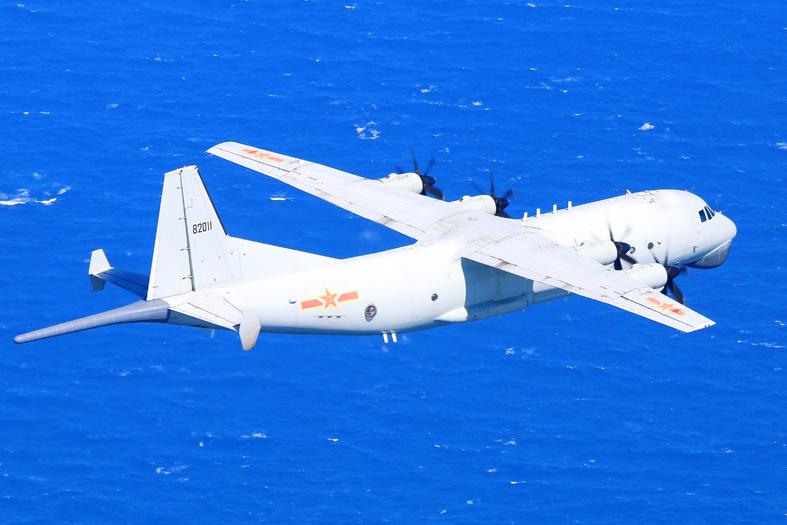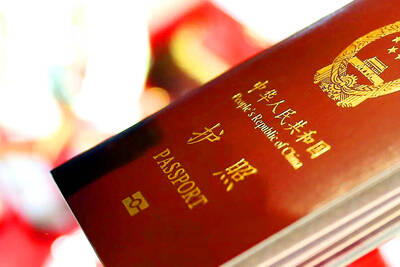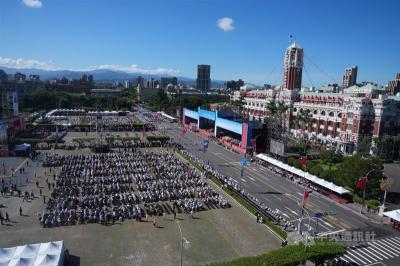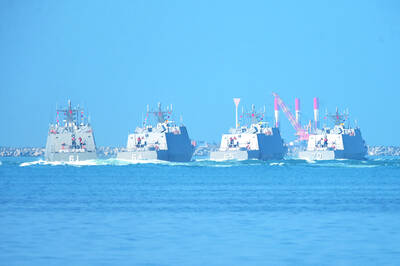The military tracked Chinese warplanes and responded as they encroached on Taiwan’s air defense identification zone (ADIZ) twice in the past four days, the Ministry of National Defense said yesterday.
Chinese fighter jets and bombers encroached on the nation’s ADIZ on Saturday last week and again on Monday, the ministry said.
On Monday, 10 aircraft — four J-16 multirole fighters, four J-10 multirole fighters, a KJ-500 airborne early warning and control aircraft and a Y-8 marine patrol aircraft — simultaneously approached Taiwan’s southwestern ADIZ from opposite directions before turning back, it said.

Photo courtesy of the Ministry of National Defense
The Japanese Ministry of Defense said that it also identified two Y-9 aircraft — one configured for reconnaissance and the other for electronic warfare — to Taiwan’s east.
Ministry spokesman Major General Shih Shun-wen (史順文) at a news conference said that the military successfully monitored the aircraft, and responded appropriately and effectively.
The military’s reaction to Chinese encroachment is determined by regulations on strategic and operational readiness, he said.
As a general principle, the military overestimates enemy capabilities, and generates a response that can anticipate and potentially block multiple, simultaneous hostile moves, Shih said.
The military avoids the “attrition trap” by varying its incursion responses by using a “high-low mix” of jets, slower aircraft, air-defense missile systems and electronic warfare, Air Force Chief of Staff Lieutenant General Huang Chih-wei (黃志偉) said.
Regarding the Japanese defense ministry’s statement, Huang said that each nation has its own criteria for disclosing defense information, but added that all threats to Taiwan were successfully monitored that day.
Association of Strategic Foresight research fellow Chieh Chung (揭仲) said that the incursions were Beijing’s way of showing its displeasure with the US, not immediate military threats.
Recent activity has been consistent with Beijing’s pattern of conducting a high-profile show of force when there is a development in US-China or Taiwan-US ties that it does not like, he said.
The Chinese aircraft were reportedly flying toward one another, but not conducting highly threatening maneuvers when circling Taiwan from opposite directions, he said, citing publicly available information.
On May 11, 2018, three formations of Chinese aircraft and ships circled Taiwan in the north, east and south, with the nearest observed aircraft only 56km from the naval base in Yilan County’s Suao Township (蘇澳), he said.
Two of the formations flew toward each other to encircle Taiwan’s eastern ADIZ, between the Bashi Channel and the Miyako Strait.
Two H-6K bombers, one Y-8 electronic warfare aircraft and one Tu-154 electronic warfare aircraft comprised the northbound group, while two H-6K bombers comprised the southbound one, he said.
The aircraft flew around Taiwan’s eastern airspace seven times from mid-April to late May 2018, Chieh said.
The military activity was a response to then-premier William Lai (賴清德) — now vice president — publicly describing himself as “a political worker for Taiwanese independence,” he said.
This story has been modified since it was first published.

The Ministry of the Interior (MOI) is to tighten rules for candidates running for public office, requiring them to declare that they do not hold a Chinese household registration or passport, and that they possess no other foreign citizenship. The requirement was set out in a draft amendment to the Enforcement Rules of the Public Officials Election and Recall Act (公職人員選舉罷免法 ) released by the ministry on Thursday. Under the proposal, candidates would need to make the declaration when submitting their registration forms, which would be published in the official election bulletin. The move follows the removal of several elected officials who were

The Republic of China (ROC) is celebrating its 114th Double Ten National Day today, featuring military parades and a variety of performances and speeches in front of the Presidential Office in Taipei. The Taiwan Taiko Association opened the celebrations with a 100-drummer performance, including young percussionists. As per tradition, an air force Mirage 2000 fighter jet flew over the Presidential Office as a part of the performance. The Honor Guards of the ROC and its marching band also heralded in a military parade. Students from Taichung's Shin Min High School then followed with a colorful performance using floral imagery to represent Taiwan's alternate name

FOUR DESIGNATED AREAS: Notices were issued for live-fire exercises in waters south and northwest of Penghu, northeast of Keelung and west of Kaohsiung, they said The military is planning three major annual exercises across the army, navy and air force this month, with the navy’s “Hai Chiang” (海強, “Sea Strong”) drills running from today through Thursday, the Ministry of National Defense said yesterday. The Hai Chiang exercise, which is to take place in waters surrounding Taiwan, would feature P-3C Orion maritime patrol aircraft and S-70C anti-submarine helicopters, the ministry said, adding that the drills aim to bolster the nation’s offshore defensive capabilities. China has intensified military and psychological pressure against Taiwan, repeatedly sending warplanes and vessels into areas near the nation’s air defense identification zone and across

A Chinese takeover of Taiwan would severely threaten the national security of the US, Japan, the Philippines and other nations, while global economic losses could reach US$10 trillion, National Security Council Deputy Secretary-General Lin Fei-fan (林飛帆) wrote in an article published yesterday in Foreign Affairs. “The future of Taiwan is not merely a regional concern; it is a test of whether the international order can withstand the pressure of authoritarian expansionism,” Lin wrote in the article titled “Taiwan’s Plan for Peace Through Strength — How Investments in Resilience Can Deter Beijing.” Chinese President Xi Jinping’s (習近平) intent to take Taiwan by force